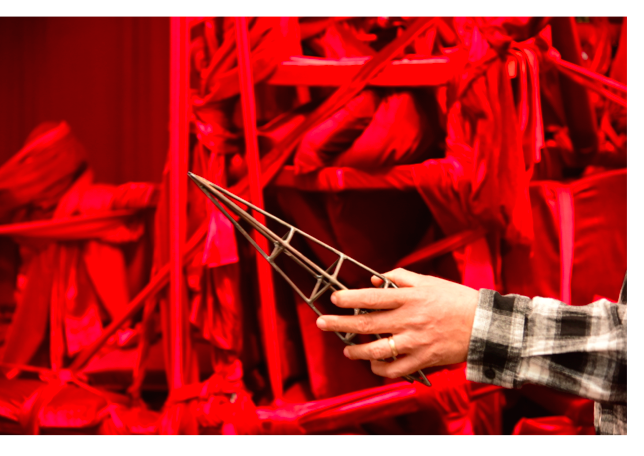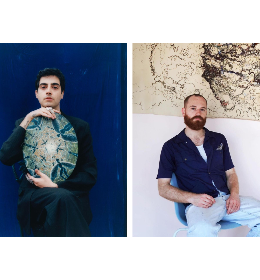"The lively spectrum of Philippine art"
 The Filipino pavilion, led by curator Dr. Patrick Flores, has made a convincing comeback after a 50-year hiatus. A four-artist exhibition balances the line between homage to the recent art history of the Philippines, and a platform for a political discourse. “I wanted to reference the lively spectrum of Philippine art, as well as presenting a history of art in the Philippines. It is a sort of arc which reflects on the robustness of Filipino modernism and how it has shaped Philippine contemporary art,” explains Dr. Flores.
The Filipino pavilion, led by curator Dr. Patrick Flores, has made a convincing comeback after a 50-year hiatus. A four-artist exhibition balances the line between homage to the recent art history of the Philippines, and a platform for a political discourse. “I wanted to reference the lively spectrum of Philippine art, as well as presenting a history of art in the Philippines. It is a sort of arc which reflects on the robustness of Filipino modernism and how it has shaped Philippine contemporary art,” explains Dr. Flores.Whilst the three pieces are visually rich and aesthetically inoffensive, there is an underlying critique of the Chinese regime in the South China Sea, 80% of which is claimed by the country. “It is about time we expressed this sentiment,” Flores tells me. The underlying political discourse is first alluded to in the film Genghis Khan, created by Manuel Conde and Carlos Francisco, and first shown in Venice in 1952. The piece, a local commercial hit, serves as an anchor to the Philippines’ history in Venice, and yet simultaneously provides a stepping-stone for a more critical political discourse about imperialism in Asia.
Jose Tence Ruiz’s piece Shoal is a representation of the Philippine ship in the South China Sea, it is the only Filipino presence in that area, “it functions and it floats, but it is rusty and pathetic, it is a pathetic sight but prevailing on the sea,” says Flores. Ruiz’s version of the Philippine ship however features a rich purple velvet covering, dotted with medieval spires, broadening the allegory, “to dwell just on the ship becomes too restrictive,” it is also this decadence and archaism links it back to Genghis Khan.
The Philippine ship in the South China Sea "functions and it floats, but it is rusty and pathetic"...
Finally, Manny Montelibano’s multichannel video piece, A Dashed State, transports us directly to the gateway to the South China Sea. The soundscape is composed of frequencies picked up from China in the southern Philippine island, interspersed with the ancient Kudaman chant. The sounds of the Chinese radio permeate the air and create an atmosphere of occupation. The film discusses the history of the sea and the making of the world through the complex representation of these disputed territories. Flores tells me how the artist was hoping to venture into the occupied waters, but the Philippine government deemed it too dangerous, so Montelibano’s film closes with a poignant image of an islander swimming the boarder with his fishing nets, practicing his trade dangerously close to the frontier, a neat illustration of what Flores calls a “poetic edge” to an open critique.
"Resource use, land reclamation and burgeoning questions of data and territorial sovereignty."
Whilst Venice is threatened by the effects of global climate change on its watery surroundings and the Philippines’ offshore territory is slowly being encroached upon, Singapore is creeping outwards into the sea. Charles Lim’s “SEA STATE” exhibition, curated byShabbir Hussain Mustafa, investigates Singapore’s “resource use, land reclamation and burgeoning questions of data and territorial sovereignty.” A nod to the Land Art of the 1970s, Lim’s drawings, photographs and videos investigate the “biophysical, aspirational and cerebral contours” of Singapore, trying to rationalize the country’s physical expansion (by 25% over the last decade taking sand from Vietnam and Malaysia to bulk out its shores) and the disappearance of certain islands and navigational markers from nautical charts. The central piece in the exhibition is the aforementioned navigational marker: the towering buoy covered in barnacles was recreated to scale by the company that made the original buoy, and plunged into Singapore’s tropical waters for four weeks. The effects on the 20-foot structure prompt us to “think about our tidal and equatorial surroundings” and their relationship with Singapore’s position as an economic power, explains Mustafa.
The power of the sea, thematic to both of these pavilions, is referenced across the biennale, the South Pacific island of Tuvalu created a sinking pavilion, flooding the Arsenale and providing footbridges for its visitors, whilst Vik Muniz’s Lampedusa sits on the canal, visible through the windows of the Singapore space, a tribute to one of the greatest humanitarian crises currently unfolding. Okwui Enwezor’s biennale is a platform for political and social discourse, and these nations, oft-unheard in Western discourse, are using this platform to internationalize these local concerns that may soon have international repercussions.
Image credit: 1. Jose Tence Ruiz, in collaboration with Danilo Ilag-Ilag and Jeremy Guiab et al. Shoal 2015 Installation Photographer: Mm Yu.









